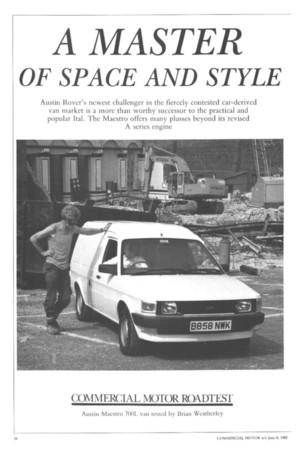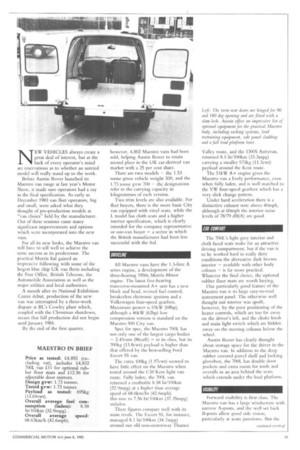A MASTER
Page 36

Page 37

Page 38

If you've noticed an error in this article please click here to report it so we can fix it.
OF SPACE AND STYLE
Austin Rover's newest challenger in the fiercely contested car-derived van market is a more than worthy successor to the practical and popular Ital. The Maestro offers many plusses beyond its revised A series engine
NEW VEHICLES always create a great deal of interest, but at the back of every operator's mind are reservations as to whether an untried model will really stand up to the work.
Before Austin Rover launched its Maestro van range at last year's Motor Show, it made sure operators had a say in the final specification. As early as December 1983 van fleet operators, big and small, were asked what they thought of pre-production models at "van clinics" held by the manufacturer. Out of these sessions came many significant improvements and options which were incorporated into the new vans.
For all its new looks, the Maestro van will have to sell well to achieve the same success as its predecessor. The practical Morris ltal gained an impressive following with some of the largest blue chip UK van fleets including the Post Office, British Telecom, the Automobile Association as well as the major utilities and local authorities.
A month after its National Exhibition Centre debut, production of the new van was interrupted by a three-week dispute at BL's Cowley plant which, coupled with the Christmas shutdown, meant that full production did not begin until January 1985.
By the end of the first quarter, however, 4,802 Maestro vans had been sold, helping Austin Rover to retain second place in the UK car-derived van market with a 25 per cent share.
There are two models — the 1.53 tonne gross vehicle weight 500, and the 1,73 tonne gvw 700 — the designations refer to the carrying capacity in kilogrammes of each version.
Two trim levels are also available. For fleet buyers, there is the more basic City van equipped with vinyl seats, while the L model has cloth seats and a higher interior specification, which is clearly intended for the company representative or one-van buyer — a sector in which the British manufacturer had been less successful with the Ital.
DRIVEL/ME
All Maestro vans have the 1.3-litre A series engine, a development of the three-bearing 1950s Morris Minor engine. The latest five-bearing transverse-mounted A+ unit has a new block arid head, revised fuel control, breakerless electronic ignition and a Volkswagen four-speed gearbox. Maximum power is 51kW (68hp), although a 46kW (62hp) low compression version is standard on the Maestro 500 City van.
Spec for spec, the Maestro 700L has not Only one of the largest cargo bodies — 2.43cum (86ctift) — in its class, but its 700kg (13.8cwt) payload is higher than that offered by the best-selling Ford Escort 55 van.
The extra 100kg (1.97cwt) seemed to have little effect on the Maestro when tested around the CM Kent light van route. Fully laden, the 700L van returned a creditable 8.58 lit/100km (32.9mpg) at a higher than average speed of 68.6km/hr (42.6mph).
this rose to 7.56 lit/100km (37.35mpg) unladen.
These figures compare well with its main rivals. The Escort 55, for instance, managed 8.1 lit/100km (34.7mpg) around our old non-motorway Thames Valley route, and the 1300S Astravan, returned 8.5 lit/100km (33.3mpg) carrying a smaller 575kg (11.3cwt) payload around the Kent route.
The 51kW A+ engine gives the Maestro van a lively performance, even when fully laden, and is well matched to the VW four-speed gearbox which has a very slick change pattern.
Under hard acceleration there is a distinctive exhaust note above 40mph, although at 60mph the interior noise levels of 78/79 dB(A) are good.
CAR COMFORT The 700L's light grey interior and cloth faced seats make for an attractive driving compartment, but if the van is to be worked hard in really dirty conditions the alternative dark brown interior — available with other body colours — is far more practical. Whatever the final choice, the optional rubber floor mats are worth buying.
One particularly good feature of the Maestro van is its large easy-to-read instrument panel. The otherwise well thought out interior was spoilt, however, by the poor positioning of the heater controls, which are too far away on the driver's left, and the choke knob and main light switch which arc hidden away on the steering colunm below the wheel.
Austin Rover has clearly thought about storage space for the driver in the Maestro van. In addition to the deep rubber covered parcel shelf and locking glovebox, the 700L has double door pockets and extra room for tools and overalls in an area behind the Seats which extends under the load platform.
VISIBIliTY
Forward visibility is first class. The Maestro van has a large windscreen with narrow A-posts, and the well set hack B-posts allow good side vision, particularly at acute junctions. But the
double rear doors have one in-built disadvantage — it is impossible to fit a tailgate wiper. In wet weather the rear windows soon foul up.
To improve rearward visibility Austin Rover need to fit larger wing mirrors than the present size of the rather small ones.
The bonded windscreen, fitted as standard, might improve body rigidity and, marginally, frontal airflow, but the cost of this is added down time if the screen is brokers. It takes at least two hours to replace the glass and up to four for the bonding adhesive to cure completely. Six hours to replace a windscreen is unlikely to be appreciated by any operator, regardless of the engineering benefits of flush glazing.
HANDLING Around CM's van route the 700L. van gave an extremely comfortable, if soft, ride. On sharp bends there was a noticeable amount of body roll, though nothing alarming. With a full 700kg load the Maestro van adopts a marked tail-down attitude, although this does not affect its excellent handling.
Steering on the front-wheel drive 700L is fairly light and precise, particularly at maximum speeds along the motorway. But there is some oversteer when cornering fast — as in the Astra van.
The Maestro van's road holding is unquestionably better than thc old rearwheel-drive hat's, although it exhibits the one disadvantage common to all front-wheel-drive vans — poor traction when restarting on steep wet gradients fully laden. Despite careful clutchcontrol the rain-swept 25 per cent (1 in 4) test gradient at the Motor Industry Research Association track had the 700L's front wheels spinning frantically, although the van stayed put. The average operator, however, would be unlikely to run into this kind of problem.
Braking was firm and positive and on the rolling road our laden 700L returned good average figures, with a total braking efficiency of 78 per cent.
Daily maintenance is straightforward. Oil, water and battery top-up points are all within easy reach in the well-laid out engine compartment.
The spare wheel is stored beneath the load platform in a cradle which is lowered by undoing a bolt in the platform.
Having removed the spare to allow a clear photograph of the Maestro's single parabolic rear leaf springs it proved an awkward and messy job to replace it, which will not please any driver on a rainy day.
SUMMARY The Maestro van is more than capable of taking over from the long-serving Ital. It has a larger than average load volume and excellent payload. This, along with its good handling and braking, will certainly appeal to operators and drivers.
Austin Rover is clearly aiming to reduce Ford's 32 per cent share of the car-derived van sector and the .4,832 price tag of the 1.3-litre 700L Maestro is identical to its arch-rival, the Escort 55.
The lack of any diesel engine option, however, puts it at a disadvantage, particularly now the diesel light van market is steadily increasing. Until the 2.0-litre joint Austin Rover Group/Perkins direct-injection engine is available "sometime in 1986" Austin Rover will have to watch while Ford, Bedford and Peugeot compete for the growing diesel orders.




































































































